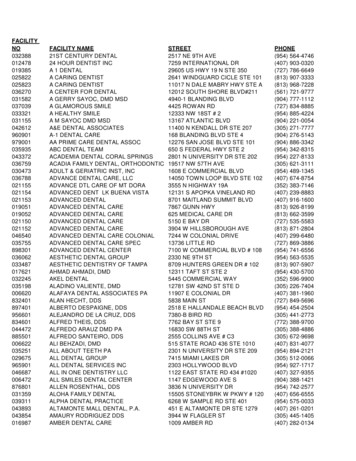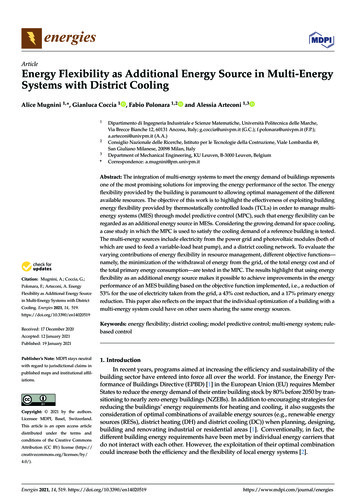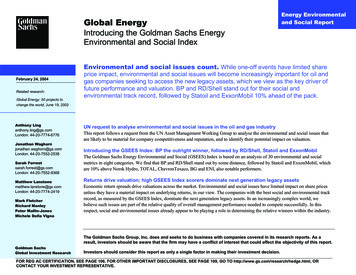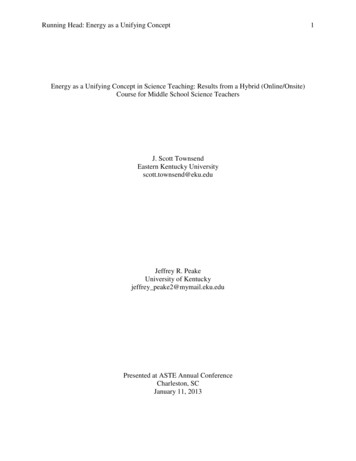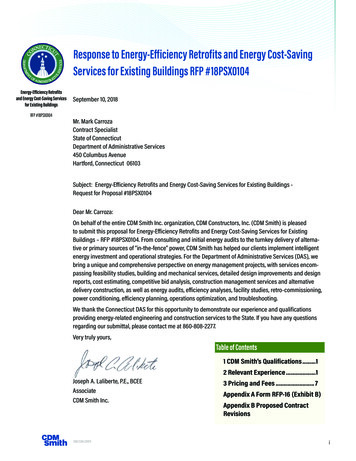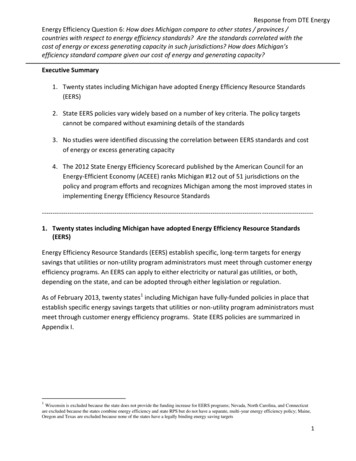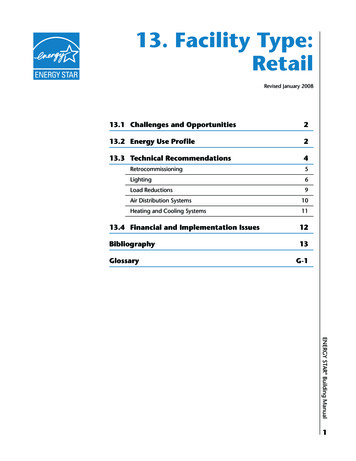
Transcription
13. Facility Type:RetailRevised January 200813.1 Challenges and Opportunities213.2 Energy Use Profile213.3 Technical Recommendations4Retrocommissioning5Lighting6Load Reductions9Air Distribution Systems10Heating and Cooling Systems1113.4 Financial and Implementation Issues12Bibliography13GlossaryG-1ENERGY STAR Building Manual1
13. Facility Type: Retail13.1 Challenges and OpportunitiesThere are approximately 657,000 retail buildings in the U.S., a number that represents about13.5 percent of all U.S. commercial space. These buildings include stand-alone facilities, stripmalls, and enclosed malls. Together, they consume approximately 21 billion worth of energyannually. The good news is that energy is one of the few expenses that can be decreased withoutnegatively affecting a retailer’s operation.Retailers stand to gain several benefits from building upgrades: Increased profitability. Energy savings are reflected on a company’s profit-and-loss statementas reduced operating costs, which directly increase the profitability of a retail operation. Reduced vulnerability to energy price fluctuations. Energy prices may be sensitive to numerousexternal factors, including major weather events and changes in national policies. For someregions, the potential for utility deregulation also lends uncertainty to future energy costs.Reducing a retail facility’s total energy consumption can soften the impact of energy price fluctuations from any of these factors. Increased sales. Improving the energy efficiency of a retail building usually involves upgradesto the lighting and HVAC systems. By creating a more pleasant shopping environment, theseupgrades can also attract and retain more customers, leading to an increase in sales. Enhanced public image. With growing concerns over global warming and other environmentalissues, many retailers want to demonstrate to potential customers that they are responsibleenvironmental stewards. Retailers can upgrade their buildings to be more energy efficient as away to achieve this goal.13.2 Energy Use ProfileENERGY STAR Building ManualWhen planning a building upgrade, consider a retail establishment’s largest energy loads. Typically, space heating and cooling, lighting, and plug loads such as computers and cash registerstogether account for nearly 70 percent of retail energy use (see Figure 13.1).2Energy intensity in retail establishments varies widely and is influenced by both weather conditions and the specific operations at the retail store, including the hours of operation, the numberof workers, the number of cash registers, and the types of refrigeration required. On-site energyintensity in retail establishments can range from less than 10,000 Btu per square foot (ft2) to morethan 200,000 Btu/ft2 (Figure 13.2). Given this large variation and skewed distribution, it can bemisleading to assess a retail building’s performance just by looking at its average energy intensity.The EPA’s national energy performance rating system is designed to provide a meaningfulbenchmark for retail facilities. The rating system is accessible online as part of the EPA’s freePortfolio Manager tool (www.energystar.gov/benchmark). It evaluates a retail facility’s energyintensity, normalizing for weather and operating characteristics. The rating is expressed on ascale of 1 to 100, signifying the percentile of performance. Retail facilities that achieve a ratingof 75 or higher are performing in the top quartile and may be eligible to earn the ENERGYSTAR label. The rating serves as a standard of comparison against other retail sites, and it provides a way to measure progress after upgrades are implemented.
Most of the electricity consumed by retail facilities is used for cooling, lighting, and plug loadssuch as cash registers, computers, and copiers; most of the natural gas is used for space heating. Each retail establishment’s energy profile is different, so these charts are not representativeof all retail spaces.ElectricCooking1%Spaceheating7%Natural ther6%13. Facility Type: RetailFigure 13.1: Electric and natural gas end-use profiles for retail facilitiesWater heating10%Other8%Refrigeration10%Lighting22%Space heating76%Plug loads20%Courtesy: E SOURCE; from Commercial Building Energy Consumption Survey, 1999 dataFigure 13.2: Distribution of energy intensity in retail facilitiesThis curve shows the overall distribution of energy use intensity among a national sample of retailbuildings. The median retail store uses approximately 70,000 Btu per square foot (ft2) from allenergy sources. Many retail facilities, however, are significantly more energy-intensive than that.120Median energy usage 67,6278060Top 25% ofretail buildings40Bottom 25% ofretail buildings2000100200300400500Energy usage (thousand Btu/ft2)600700Courtesy: E SOURCE; from Commercial BuildingEnergy Consumption Survey, 2003 dataENERGY STAR Building ManualNumber of retail buildings (thousands)1003
13. Facility Type: RetailRetail establishments should begin all upgrade projects by establishing a benchmark rating.The relative ENERGY STAR ratings can help an organization identify their best- and worstperforming facilities. Although any retail establishment may benefit from retrocommissioning,operational improvements, and retrofits, low-scoring facilities stand to benefit the most.For more information, visit ENERGY STAR for Retail at www.energystar.gov/retail. Fordescriptions of retail facilities that have earned the ENERGY STAR, visit www.energystar.gov/index.cfm?fuseaction PARTNER LIST.showPartnerResults&leaders yn N&poyyn N&success yn N&partner type id CIR&s code ALL.13.3 Technical RecommendationsAlthough building systems in retail establishments vary, common reasons for initiating energyrelated upgrades include: Equipment that malfunctions frequently or experiences shortened lifetimes due to years ofdeferred maintenance Piecemeal additions to buildings or internal changes to existing spaces made without corresponding changes to heating and cooling systems Previous attempts to reduce energy consumption that used inappropriate measures such asblacking out windows or covering vents Public spaces with inadequate ventilation systems, high levels of indoor air pollutants fromproducts, or poor acousticsRESOURCES: Retail organizationsThe following organizations offer resources that can help owners and operators of retailfacilities manage energy use.National Association of Convenience Storeswww.nacsonline.comENERGY STAR Building ManualThe National Association of Convenience Stores is an international trade association representing 2,300 retail and 1,700 supplier company members.4National Association of Store Fixture Manufacturerswww.nasfm.orgMember companies offer a full range of products and services for retail environments andinclude store fixture suppliers, retail design firms, suppliers of visual merchandising products, and suppliers of materials and equipment for the retail environment industry.National Retail Federationwww.nrf.comThe National Retail Federation represents more than 100 state, national, and internationaltrade organizations.
Multiple rooftop air-conditioning units that are hard to control individually Major capital equipment or building infrastructure, such as a boiler or a roof, that is nearing the end of its useful lifeIn addition, following the staged approach that is advocated throughout this manual can revealopportunities for saving on capital costs by “right-sizing” major equipment. After lighting andload-reduction measures have been implemented, it may be possible to specify smaller heatingand cooling equipment.Many of the following recommendations provide not only energy savings but also maintenancesavings. Please note that this should not be considered an exhaustive list of measures appropriate for retail spaces. Facility directors for retail establishments are encouraged to refer to the fullguidelines presented throughout this manual when planning and managing a building upgrade.13. Facility Type: Retail RetrocommissioningEnergy savings and other benefits. Most of the opportunities that are identified duringretrocommissioning concern HVAC systems and, in particular, air-distribution systems. Theamount of savings achieved will depend on the types of problems that are identified and theremedies that are implemented.Retrocommissioning can also produce non-energy benefits. It can reduce equipment downtimeand keep maintenance expenditures in check. Retrocommissioning may also create a more pleasing shopping environment by identifying poorly performing ventilation systems, which can be aculprit in poor indoor air quality. Problems with low-voltage electrical systems such as lighting,alarm, and building management systems are frequently identified during retrocommissioning.Best practices. If a retailer’s staff has sufficient expertise and familiarity with a building’s systems, they may carry out the retrocommissioning work. However, retail facilities aremore likely than other building types to outsource this work. Regardless of who does thework, training and documentation are crucial to successful efforts, as described in Chapter 5,“Retrocommissioning.”Tune-up opportunities. There are a number of easy measures that can reduce energy usein various store areas:Storewide. Turn HVAC temperature settings down in heating seasons and up in coolingseasons, while still maintaining comfortable conditions, and turn lights off when they arenot in use. Occupancy sensors and timers can help with the latter, but a less-expensivealternative would be to develop a standard store-closing protocol for shutting off lightsduring closed hours. Displays. Many stores have electronic displays that remain on even when the store is closed.Consider shutting off the displays during closed hours either manually or with simple timers. Peripheral rooms. Make sure that HVAC settings in stockrooms, offices, and other peripheral rooms are at minimum settings.Integration with facility planning. For retailers with multiple buildings, the completeretrocommissioning of select facilities as well as an assessment of the condition of their remaining buildings can be used to develop a multiyear facility management plan. The retrocommissioning programs could provide a model to follow for planning and prioritizing projects atother similar stores, while keeping the longer-term impact of those decisions in perspective. Atypical facility assessment includes reviewing the age and condition of building componentsENERGY STAR Building Manual 5
13. Facility Type: RetailRESOURCES: RetrocommissioningThe following organizations offer resources that help owners and operators of retail facilitiesto assess how effectively they currently use energy and to investigate efficient alternatives.Building Commissioning Associationwww.bcxa.orgThe Building Commissioning Association aims for diverse and creative approaches to building commissioning by focusing on identifying critical commissioning attributes and elements,rather than attempting to dictate a rigid process.California Commissioning Collaborativewww.cacx.orgThe California Commissioning Collaborative is a non-profit organization made up ofgovernment, utility, and building services organizations and professionals, and providescommissioning information and resources for providers and building owners.Edison Electric Institute, National Accounts Programwww.eei.org/industry issues/retail services and delivery/National Accounts/about/index.htmThe Edison Electric Institute’s National Accounts Program focuses on the unique needs of thosecommercial customers with multiple sites or outlets, including chains and franchise operations.Food Marketing Institutewww.fmi.org/energy/The Food Marketing Institute is a nonprofit association that conducts programs in research,education, industry relations, and public affairs on behalf of its members and their subsidiaries, which include food retailers and wholesalers and their customers in the United Statesand around the world.Portland Energy Conservation Inc.www.peci.orgPortland Energy Conservation Inc. provides commissioning guidelines and services and promotes energy-efficient practices and technologies for businesses and individual consumers.Professional Retail Store MaintenanceENERGY STAR Building Manualwww.prsm.com6Professional Retail Store Maintenance is a member organization promoting the awarenessof retail facilities management and its impact on the success of retailers.and then estimating their remaining expected lifetime and replacement costs. A number ofresources are available to help operators of retail facilities assess their current operations andbegin their investigation of energy-saving alternatives (see sidebar).LightingEnergy savings. Lighting represents about 22 percent of the electricity consumption in atypical retail establishment, not including its effect on cooling loads. Lighting retrofits can save30 to 50 percent of lighting energy as well as 10 to 20 percent of cooling energy.
The Illuminating Engineering Society of North America (IESNA) sets illumination standardsby task. Keep in mind that the IESNA guidelines do not heavily emphasize energy savings ordaylighting. When daylighting is incorporated into a retail lighting strategy, the range of illumination levels can vary much more widely than with electric lighting alone.13. Facility Type: RetailBest practices. Lighting is of critical importance to retailers because it can drive higher salesrevenues. Products need sufficient illumination to attract attention from consumers, yet careis needed to protect some products from being overheated. Many retailers may not realize thatcontrasting light levels, not total light levels, make products stand out from their surroundings.Therefore, only key product areas should be highlighted—too much accent lighting not onlyuses more energy but negates contrast. Accent light levels can also be lowered when generalillumination levels are kept lower. Although window display lighting levels may need to behigh during the day to provide contrast in sunlit spaces, they can be lowered at night becausecontrast will be easier to achieve.Daylighting. Natural daylight offers two benefits over electric lighting in retail spaces. First,it can save energy by reducing the need for electric lights. For example, the Costco chain ofdiscount stores began installing skylights and daylighting controls into its stores in the 1980s,and it now includes them as standard items in new stores. The payoff: projected annual energysavings of 1.5 kilowatt-hours/ft2 per facility (approximately 23,000).Second, there is some evidence that natural daylight can improve retail sales. A study sponsoredby the California Energy Commission, published in 2003, looked at sales in 73 of one retailer’sstores, 24 of which had a significant amount of daylighting. It calculated that the average effectof daylighting was to increase sales by up to 6 percent. The study also found that stores in areasthat had more hours of useful daylight per year showed a greater daylight effect on sales.Electric lighting. A mixture of light sources can create a pleasing and comfortable environment that is energy efficient and suitable for a variety of tasks. Electric lighting should be coordinated with a daylighting scheme or adjusted in response to it. A blend of direct and indirectelectric lighting can provide soft and uniform illumination.For general illumination in retail establishments, fluorescent lighting provides an efficientoption with good color quality. If a facility uses T12 fluorescent lamps and magnetic ballasts,relamping with high-performance T8 lamps and electronic ballasts can reduce lighting energyconsumption by 35 percent. Adding specular reflectors and new lenses can create additional savings. For big-box stores with high ceilings, ceramic metal halide (CMH) lamps and high-outputThe owner of an Ace Hardware store in Martinez, California, sought to improve the quality of light in the store and reduce operating costs through a lighting upgrade. This wasaccomplished in part by using solar-tracking skylights instead of conventional ones. Thistechnology uses multiple reflectors to track the sun and direct its light into the buildingthrough a diffuser, thereby achieving natural lighting of greater coverage, consistency, andduration than attainable with conventional skylights. In addition, the store’s existing T12fluorescent lamps and magnetic ballasts were replaced with T8 lamps and electronic ballasts. A light sensor in a skylight well turns on the electric lights when needed. Short-termmonitoring revealed a 65 percent energy savings; for the 14,400-ft2 facility, that workedout to be about 4.9 kilowatt-hours/ft2.ENERGY STAR Building ManualCASE STUDY: Hardware Store Cuts Costs with Lighting Upgrade7
13. Facility Type: RetailCASE STUDY: Staples Store LightingStaples has made lighting efficiency a top priority throughout its national chain of retailoffice-supply stores. In 2003, it retrofitted 647 stores with single-lamp T8 fixtures, replacing two-lamp T8 fixtures except around the store perimeter. Though this change resultedin lower light levels, the stores appeared brighter because they used lamps with a highercolor temperature (4,100 versus 3,500 kelvins) that gave off more blue light. The lightingupgrade resulted in a 6-million-watt annual reduction in energy use across all the stores.Although some research has shown that visual acuity improves under light that emits moreintensely in the blue part of the spectrum, the lighting community is not unanimous on thesubject. However, Staples’ experience seems to support the claim.T5 fluorescent lamps are also good high-efficiency options. Office Depot replaced old metalhalide lighting with T5 fluorescent lighting and not only cut energy use by about one-third, butincreased light levels by 50 foot-candles as well.For retail accent lighting, low-wattage CMH lamps with electronic ballasts are a good choice.They provide good color, long life, and high efficiency, and are now available in sizes as smallas 20 watts to replace commonly used 75-watt halogen lamps. CMHs are available in popularMR16, PAR20, and PAR30 configurations.For display cases and under-shelf illumination, T5 fluorescent lamps are a good choice. Theyare small in size and highly efficient, and they also have good color quality.ENERGY STAR Building ManualAnother option for accent lighting is fiber optic lighting, in which a single high-efficiency lightsource feeds multiple remotely placed fixtures. Although installation can be costly, remotesource lighting offers a number of benefits important in retail applications, including minimizing the introduction of infrared and ultraviolet energy, allowing the use of more-powerfuland more-efficient light sources, providing better targeting of the light, reducing maintenancerequirements, and providing aesthetic appeal.8Light-emitting diodes (LEDs) also have a role to play in retail outlets. Retail accent lighting is agrowing area for LEDs because they provide the ability to vary color, create sparkle, and aim thelight precisely. The Alessi store in New York City uses LEDs to accent a line of stainless-steel products including coffee makers, containers, and flatware. For stores with refrigerated products, LEDsare a good solution for illumination inside refrigerated display cases because they do not create asmuch heat as fluorescent or incandescent lamps. If LED exit signs are not already in place, this isone retrofit that is usually a clear winner for any retailer, not only for how much energy it can savebut also for maintenance savings. An ENERGY STAR qualified LED exit sign can go 25 yearswithout lamp replacement, compared with less than 1 year for an incandescent sign.Outdoor lighting is important for maintaining security and shopper
Building Manual 3 13. Facility Type: Retail Figure 13.1: Electric and natural gas end-use profiles for retail facilities Most of the electricity consumed by retail facilities is used for cooling, lighting, and plug loads such as cash registers, computers, and copiers; most of the natural gas is used for space heat-ing.
